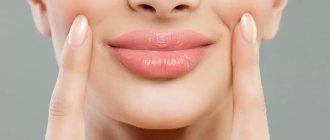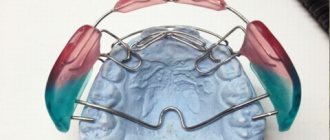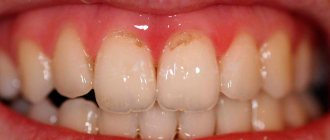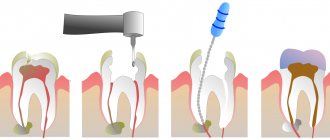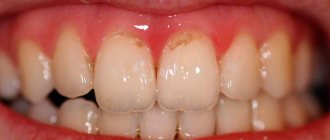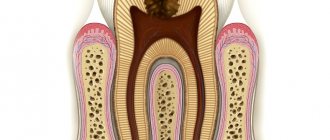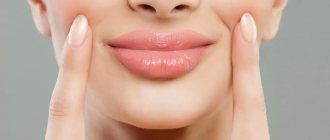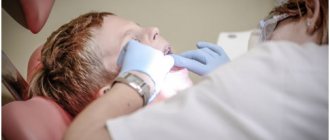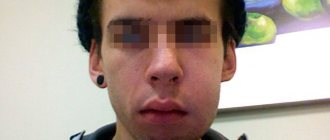Causes
Vascular occlusions are associated with a state of vascular insufficiency. The occlusion process occurs:
- as a result of injuries, if the artery is compressed.
- due to the fact that the lumen is blocked by a thrombus or embolus.
The formation of blood clots is promoted by a chronic disease - vascular atherosclerosis. As atheromatous plaques grow and increase in diameter, they interfere with normal blood flow. Atherosclerotic plaque leads to blood clotting and blood clot formation. Occlusion is caused by separated plaque fragments that move freely along the vascular bed. In addition, as a result of atherosclerosis, the walls of blood vessels lose their elasticity, become thinner and stratify under blood pressure, which causes the formation of aneurysms. Thrombosis or embolism is likely to occur in the area of the vessel where the dilatation has appeared.
Yesterday Today Tomorrow
Orthognathic occlusion
Orthognathic occlusion is characterized by A, B and C contacts (“A” between the buccal cusps, “B” - between the buccal and palatal cusps, “C” - between the palatal and lingual cusps, translator’s note). This is how nature works, although in many cases there are deviations from the classical picture. During the chewing process, the resulting vector of forces in the upper jaw is oriented upward and slightly in the buccal direction. However, in the manufacture of implant-supported prosthetic work, and in particular complete removable dentures, this direction of force influence negatively affects the statics of the prosthesis (Fig. 2a).
In Fig. Figure 2b analyzes the direction of force vectors on various internal slopes of the cusps (facets) of the mandibular molar on the left. It can be seen that only on one internal slope of the tubercle (facet) the force acts in the oral direction and upward (green line). In the area of the other two facets, the force acts in the buccal direction (red lines). This results in destabilizing torques in the area of the buccal cusps, causing the prosthesis to tip over.
Rice. 2a. With unilateral loading on the left side, the prosthesis on the right side is reset.
Rice. 2b. Upper molar: lines indicate the direction of forces in the area of each internal slope of the cusp (facet). The blue line marks the resulting vector of forces. It is directed outward from the alveolar ridge and this leads to the shedding of the prosthesis.
Rice. 2c. Molars in occlusion, contacts A, B, C according to Gysi. Standard modern set of artificial teeth (side view).
Features of prosthetics on implants
The greater the distance from the supporting structure (alveolar ridge) to the occlusal surface of the tooth, the more outward in relation to the supporting structure the action of the chewing force is directed. When using prosthetics on implants, the lever arm is larger, and, accordingly, the torsion (torque) force acting in the area of connection between the implant and the superstructure is greater (Fig. 3).
Rice. 3. For contacts in the area of the buccal cusps, the force acts in the buccal direction. This causes the screws on the implants to loosen or break.
Occlusion of cardiac vessels
A dangerous condition is considered to be acute occlusion of the coronary arteries, which supply blood to the heart muscle. This occurs as a result of atherosclerosis of the coronary arteries and coronary heart disease. If, during the chronic course of the disease, a person experiences angina pectoris, then the acute form is fraught with a heart attack and even death of the patient. Typical signs of cardiac vascular occlusion are chest pain that lasts more than 10 minutes and does not go away with rest or after taking nitroglycerin. In this case, the concept of acute coronary syndrome is used: a patient with such symptoms should be immediately hospitalized.
The danger lies in the fact that a person initially ignores the symptoms of coronary artery disease or simply does not feel them without taking any measures. Vascular occlusion is characterized by suddenness and unexpectedness, so at the first signs of developing coronary artery disease, consult a doctor immediately.
“Reduced” occlusion according to Gerber® (reduzierte Okklusion)
To eliminate the effects of destabilizing forces in complete removable prosthetics, the principle of reducing the surface of occlusal contacts in the area of the buccal tubercles has been used for 50 years (“reduced” occlusion according to Gerber®, Gerber A., 1960, 1965,1973). Due to this, the point of application of the load shifts in the lingual direction and the force vector is directed almost vertically (Fig. 4a, 4b).
Rice. 4a. When the buccal cusps are separated by approximately 2 mm, the chewing force acts in the lingual direction (indirectly, through the bolus). The effect of force in the buccal direction is significantly reduced.
Rice. 4b. Molars in occlusion, lateral view. Set of teeth for working according to the Gerber® method.
The less contact between the buccal cusps (contact opening), the greater the effect of stabilizing the occlusion. In complete removable prosthetics according to the concept of “reduced” occlusion, the separation of the buccal tubercles should be at least 2 mm. With a very favorable ratio of alveolar ridges, sufficient salivation and viscous saliva, contacts between the buccal cusps are allowed so that the denture on the upper jaw does not tip over (carry out a test using cotton rolls).
Peripheral vascular occlusion
Large arteries of the extremities, more often the lower ones, are susceptible to vascular occlusion. Occlusions are an unpleasant consequence of vascular diseases of the legs. At the same time, the threat of an acute occlusive process in this area is dangerous due to the development of tissue necrosis, which leads to amputation of the affected limb. Characteristic signs of thromboangiitis obliterans, atherosclerosis of leg vessels and other common pathologies are:
- pain in the legs that does not go away with rest;
- pallor of the skin of the extremities;
- coldness in the legs;
- tingling sensation, numbness in the limb;
- impairment of motor functions of the limb.
If these symptoms appear, it is recommended to immediately examine and treat the vessels of the extremities: the slightest delay can result in the development of gangrene. In the early stages of the development of the disease, treatment of obliterating atherosclerosis of the lower extremities and other pathologies of sclerotic origin is carried out using conservative methods, whereas in an advanced form it is difficult to fight the disease.
Occlusive processes occur in the arteries of the kidneys, resulting in the development of renovascular hypertension and kidney dysfunction. The aorta is also affected, since it is the largest vessel. Read about the consequences of aortic atherosclerosis by clicking on the link.
The ultimate goal of using any moisturizer is to increase the degree of hydration of the stratum corneum of the epidermis, however, the mechanisms of action of different moisturizers vary
We suggest understanding the main moisturizers included in cosmetic products, but in order to choose the right moisturizer, a specialist must understand the various categories of moisturizing ingredients and know the principles of their individual and combined use.
It is known that dry skin can be eliminated by moisturizing the stratum corneum with occlusive (moisture-holding) ingredients or humectants, as well as by softening the epithelium with emollients (softeners). It is customary to distinguish two types of ingredients: occlusives and humectants. A good moisturizer usually contains both types.
Mechanism of action of humidifiers
There are numerous moisturizers on the market that have one goal: to increase the water content in the stratum corneum of the epidermis. This goal is achieved by blocking the process of evaporation of water from the skin (due to occlusive ingredients) or by reducing the permeability of the skin barrier. The permeability of the skin barrier can be reduced by providing the proper amount of fatty acids, ceramides, cholesterol, and by controlling the calcium gradient. Another way to hydrate your skin is to increase your skin's ability to retain moisture. This goal is achieved by increasing the concentrations of NMF, glycerin and other humectants such as hyaluronic acid. Finally, skin hydration can also be achieved by increasing the ability of the epidermis to absorb important components such as glycerol and water through aquaporin channels.
Occlusions
Occlusives reduce transepidermal water loss (TEWL) by creating a film on the surface of the skin. Typically, occlusives are oily substances that have the ability to dissolve fats, and therefore they are widely used as components of cosmetic skin care products. The use of occlusives is one of the optimal ways to care for dry skin, since it simultaneously provides both skin hydration and a reduction in TEWL. The best occlusives available today are Vaseline and mineral oil.
In particular, Vaseline reduces water evaporation 170 times more than olive oil. However, using Vaseline causes discomfort, and therefore for many people this product is not suitable for cosmetic reasons. In addition to petroleum jelly, paraffin, squalene, dimethicone, soybean oil, grape seed oil, propylene glycol, lanolin and beeswax are often used in cosmetology practice. In addition, natural oils, such as sunflower oil, are becoming increasingly popular. Occlusive agents are only effective when present on the surface of the skin; when they are removed, the TEWL is restored to its original level. Interestingly, it is not recommended to reduce TEWL by more than 40%, since this may cause maceration and an increase in the number of bacteria. If it is necessary to achieve skin hydration, occlusive agents are usually used in combination with humectants.
Humectants
Humectants (water-retaining agents) are water-soluble compounds with a high ability to absorb water. They have the ability to attract water from the atmosphere (if air humidity exceeds 80%) and from the underlying epidermis. Although humectants can capture water from the environment to provide hydration to the skin, in low humidity conditions they can capture water from the underlying layers of the epidermis and dermis, thereby drying out the skin. For this reason, they are best used in combination with occlusives. Humectants are often added to cosmetic moisturizers because they prevent evaporation and increase the thickness of the applied product layer, thereby increasing the duration of the effect. Humectants attract water into the skin, causing slight swelling of the stratum corneum of the epidermis, resulting in smoother skin with fewer wrinkles. As a result, people refer to many moisturizers as “anti-wrinkle creams,” even though they don't have that effect. The most commonly used humectants in everyday life are glycerin, sorbitol, sodium hyaluronate, urea, propylene glycol, α-hydroxy acids and sugars.
Emollients
This is a category of substances added to cosmetics to soften and increase the smoothness of the skin. The action of emollients is to fill the spaces between exfoliated corneocytes to provide a smooth surface. Emollients provide increased cohesive properties by flattening the edges of corneocytes. This is accompanied by a smoother surface, less friction and increased light reflection. Many emollients also function as humectants and occlusive humectants. Examples of occlusive ingredients that also have emollient properties are lanolin, mineral oil and petroleum jelly.
Skin barrier components
Over the years, many studies have examined the utility of using the primary lipid components of the skin barrier—ceramides, cholesterol, and fatty acids—to improve skin barrier function and ultimately improve skin hydration. Experiments and studies have shown that application of a combination of cholesterol, ceramides and essential/essential free fatty acids in equimolar ratios provided a normal rate of restoration of barrier function, but at a ratio of 3:1:1 the rate of restoration was accelerated. Currently, the goal of the best moisturizers that provide optimal restoration of barrier function is to maintain a 3:1:1 ratio of the above components.
And so, occlusives create a film on the stratum corneum and reduce TEWL; humectants “pull” water from the atmosphere and from the underlying epidermis, moisturizing the skin; emollients soften and smooth the skin.
*Based on materials from “Cosmetic Dermatology”, L. Baumann
Occlusion of blood vessels supplying blood to the brain
Occlusive processes in the arteries supplying the brain are fraught with dangerous consequences. Impairment of cerebral blood supply is fraught with the development of a stroke or ischemic cerebral infarction, and this often ends in the patient’s death, paralysis or dementia. A common cause of this is carotid artery occlusion. It is accompanied by loss of consciousness, nausea and vomiting, impaired coordination, speech and vision, weakness and numbness of the limbs. A harbinger of strokes are transient (cerebral) ischemic attacks, which we described in detail earlier.
Occlusion according to Bosschaert, oriented to the alveolar ridge (kammorientierte Okklusion, KO)
Targeted changes in the relief of the occlusal surface of artificial teeth further increase the stability of dentures during chewing. With a one-sided load, the prosthesis on the upper jaw does not tip over, i.e. the situation from a static point of view is favorable (Fig. 1 and Fig. 6).
As in the dental sets developed by prof. Albert Gerber®, the buccal cusps of the upper molars from sets of teeth were reduced in size using the Bosschaert method. Due to the wide surface of the internal slopes of the supporting tubercles (like “erasing facets”) and the planar contact between them, the force vector is reoriented in a favorable direction - upward and inward (Fig. 5a - c). In order to reduce the impact of forces in an unfavorable direction, there is only point contact in the area of the lingual tubercle. It is necessary to ensure “centricity” in the transversal plane.
Thanks to the pronounced convex buccal surface of the molars, good contact with the cheek is ensured, and the aesthetically important buccal corridor is preserved. Close contact with the cheek surface has the following advantages:
- creates an obstacle to the penetration of the food bolus into the vestibule of the oral cavity, as well as under dentures;
- promotes a stable position of the prosthesis and neutralizes tongue pressure (muscular balance);
- significantly reduces the likelihood of cheek biting.
Rice. 5a. The wide surface of the slopes of the supporting tubercles is of the “erasure facets” type (the upper jaw is the internal slope of the palatine tubercle, the lower jaw is the internal slope of the buccal tubercle). Pronounced plane contact in the area of the internal slopes of the supporting cusps (facets) of the upper and lower molars. The buccal cusps of the upper molars are significantly reduced in size.
Rice. 5 B. Max Bosschaert's patented DeltaForm posterior teeth (side view).
Rice. 5th century Transverse section through the lower molar (DeltaForm posterior set). A pronounced planar contact is clearly visible in the area of the internal slopes (facets) of the supporting tubercles. The central fossa (Fossa) is significantly displaced in the lingual direction, i.e., lingualized. This provides additional stability and lingual inclination of the teeth according to the Monson spherical surface/Wilson curve principle.
Rice. 6. To check the statics of the prosthesis, cotton rolls are placed between the molars on one side. Dentures for the upper and lower jaws remain stable and do not move.
New concept and implant prosthetics
Fixed structures supported by implants on the upper and lower jaws
The use of the Bosshart occlusal concept in the manufacture of implant-supported restorations on both the upper and lower jaws simultaneously promotes better load distribution due to the directed reorientation of the masticatory pressure force vector. It then acts in the area of the supporting elements in the orthograde (natural, physiological) direction, i.e. along the axis of the implant. For an implant on the upper jaw - in the upward and inward direction, and on the lower jaw - downward and outward (Fig. 7).
